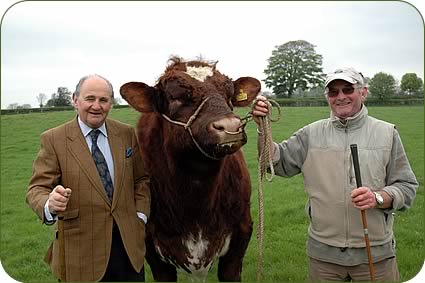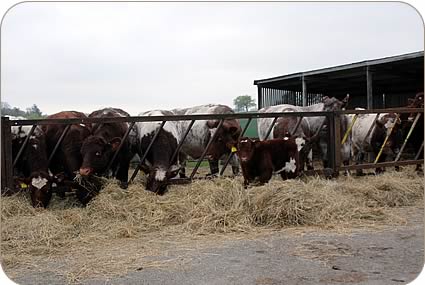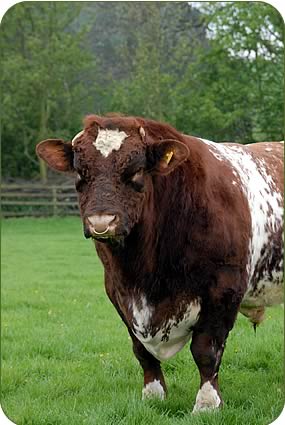Jennifer MacKenzie is an agricultural photo journalist with almost 30 year's experience. Operating from her base in Cumbria, Jennifer undertakes mainly industry-related freelance writing and photography.
Newfield Beef Shorthorns
A mission to find a particular type of duck led to the foundation of a successful pedigree beef herd in north Yorkshire 20 years ago.
Michael Abrahams and his farm manager Ray Sanderson had until 1986 been buying in and finishing continental store cattle at Newfield, Mickley, near Ripon.
However, the difficulties in managing the flighty store cattle led to the decision to set up a pedigree herd of cows with a quiet temperament.
 |
| Michael Abrahams, left, and
farm manager Ray Sanderson, with stock bull Cairnsmore Thrasher. |
It was by accident that Ray spotted the Beef Shorthorn herd run by The Hon Gerald Turton at Upsall Castle, near Thirsk – while he was out trying to buy some ducks.
While the ducks never arrived at Newfield, the Beef Shorthorns did, starting two decades of breeding which has resulted in numerous show wins and has commanded leading prices at breed sales in Perth.
“It was just by accident that I came across these cattle when I was at a neighbouring farm in search of the ducks,” said Mr Sanderson.
“At the time we were considering starting a pedigree beef herd and these cattle took me back to the days of my grandfather and they reflected the history of farming in this region,” he added.
“We had been considering starting a continental herd but because of their popularity I thought why not breed something that no one else wants to breed and eventually they will become interested. The Shorthorns generated a lot of interest from our neighbours. The size of the financial investment was a lot less than in continentals.
“And while we had never bred cattle here before, it was amazing how placid the Shorthorn cows were and how easy they were to work with.
“The Abrahams get a lot of visitors to the farm through their equestrian interests and strangers can walk among the cows and even those with newborn calves without any problem.”
In 1986 the Newfield herd was established with seven females from the Upsall herd.
The following year Mr Abrahams visited Scotland and additions to the herd were made from the Chapelton, Fingask, Glenisla and Uppermill herds.
 |
| Newfield Beef Shorthorn cows
and a one month old bull calf by stock bull Cairnsmore Thrasher. |
Further investment was made in 1990 in 60 breeding cows from the dispersal of Miss Mary Furness’s Otterington herd. Since then all herd females have been home-bred with only stock bulls purchased.
It was the private purchase of stock bull Chapelton Eclipse which helped set the herd on the road to success, marrying with the various bloodlines purchased.
Mr Sanderson spotted his potential at as early an age as one month and he was eventually bought at 16 months old after being exhibited at the Royal Highland Show.
In particular, the small, square, old fashioned Otterington cows bred well with the big Chapel ton sire which weighed one and a half tonnes and sold as a six year old to Shetland breeder Derek Black for his Toab herd.
A three times Great Yorkshire Show breed champion, his progeny went on to take the leading prizes and prices at Perth’s October bull sales.
In 1994, Newfield Gambler the show champion sold for 5,800gns at two years old. His bloodlines continue to sell well with the Perth champion in 2004 Newfield Torque selling for 4,800gns to Andy Ryder’s herd at Moffat.
Two on farm sales have depleted herd numbers now to a dozen breeding cows with most of Newfield’s 168 acres rented out for sheep grazing.
While herd numbers have been reduced, the enthusiasm for the breed shown by both Mr Abrahams and Mr Sanderson has not diminished.
Mr Abrahams is the current president of the Yorkshire Agricultural Society and he has high hopes for his stock bulls at this year’s event. Senior bull Cairnsmore Thrasher bred by Jane and John Landers, of Newton Stewart, and homebred three-year-old Newfield Xerxes which are entered for this year’s show at Harrogate in July.
The cows, which calve from mid March, are in calf to Thrasher while five herd replacement heifers are in calf to Newfield Xerxes.
 |
| Newfield stock bull Cairnsmore Thrasher |
One of the herd’s most successful show cows was an Eclipse daughter, Newfield Harmony Ruby that Ray describes as ‘an exceptional animal’. In seven years of showing at the Yorkshire in the early 1990s from a yearling heifer she was never beaten.
And Mr Sanderson, a past Royal Show judge, judged a strong line-up of Beef Shorthorns at the Royal Highland Show, an event he has not attended for some years.
He applied the criteria he has used with Mr Abrahams to select cattle for the Newfield herd, generally favouring the roan coloured animals and placing importance on wide muzzles for foraging ability, bright eyes indicating temperament and well set ears to show there is ‘something in between them’!
He also selects for a good coat and feet, round boned animals which are preferably naturally polled. He places great emphasis on the breed’s maternal traits.
For the Newfield herd, he has been keen to maintain certain families mainly from more dairy lines with proven milking ability to keep this important trait – the Tanzy family has been noted for this.
He is also keen to source bloodlines from the UK rather than from North America.
“I think the breed has a good future. We have set up a group in north Yorkshire to promote and sell the breed to both commercial and pedigree breeders and we have a successful sale at Thirsk in October.
“With less labour on farms, their placid nature and being easily handled means they are ideal. They are also suitable for organic systems. The meat is very good and nicely marbled with fat.”
Bull calves are earmarked as potential breeding bulls and the reminder are wintered on haylage and finished at 18 to 20 months old, selling to Otley butcher Gillams.
The breeding bulls readily sell to both commercial and suckler herd owners.
The Newfield herd, although not registered organic, is run on organic and traditional lines with no artificial fertiliser used.
The cattle’s main diet is grass and haylage, which is also produced for the Newfield horses.
Concentrate is only fed to show teams and to bulls a month prior to sale. The farm is renowned as a good stock rearing unit with its limestone pastures.

